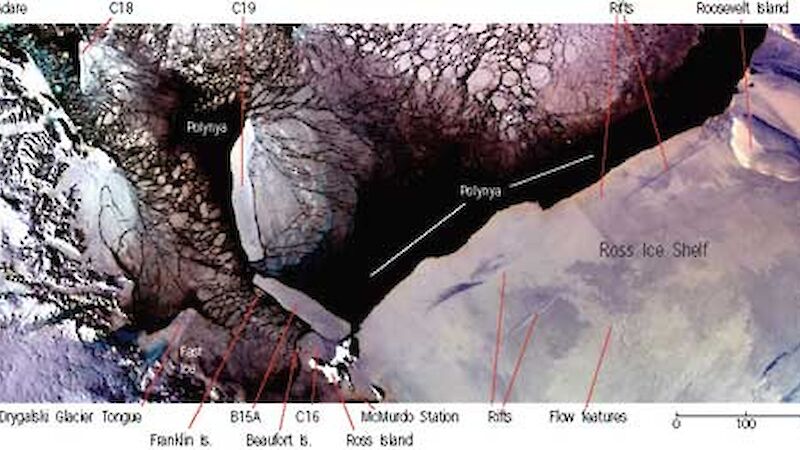In May 2002, another massive iceberg calved from the western section of Ross Ice Shelf to become the third largest that has been observed. Iceberg C19 is about 200km long and 32km wide. Shortly before that event, iceberg C18 calved from the front of the Ross Ice Shelf immediately to the east. Together with the calving of icebergs B15 and others in 2000, these events have resulted in the loss of a significant area of ice from about 90% of the length of the ice shelf front. There is only a small section of about 60–70km near the middle of the front has not suffered a major calving event in the past two years, and indeed not for at least 45 years.
When added to the amount of ice in the massive icebergs that calved from the Ronne Ice Shelf in 2000, and from the Thwaites Glacier, Pine Island Glacier, and Larsen ‘B’ Ice Shelf over these past two years, taken together they represent several times the annual average turnover of ice through the whole of the Antarctic ice sheet. However, because the icebergs come from the floating sections of the ice cover, the calving events alone do not have an impact on sea level.
The movement of massive icebergs is primarily influenced by ocean currents in the upper few hundred metres of the ocean, and so their movements act as tracers of those currents. So far, the recently formed icebergs have drifted distances that range from only a few kilometres to over a thousand kilometres. B22 (Australian Antarctic Magazine 3:36) has remained close to Thwaites Glacier. The locations of B15A, C16, C18 and C19 can be seen in the MODIS image of the Ross Ice Shelf above.
The tracks of icebergs B9 and B10 that calved over 15 years ago give us an insight into the likely future drift tracks. For instance iceberg B9 calved from the east end of Ross Ice Shelf in 1987. It drifted slowly out of the Ross Sea and broke into three sections as it passed Cape Adare. The three sections became grounded for various periods around the sector of Antarctic coast south of Australia. Sections B9A and B9C began drifting again in the late 1990s, and moved westwards around the coast. B9C moved north through Prydz Bay, whereas B9A continued westwards, circumnavigating about two-thirds of Antarctica. It has passed through the southern part of the Weddell Sea, north along the Antarctic Peninsula, then headed eastwards. It has recently turned sharply north and west round the South Orkney Islands into Scotia Sea. Other icebergs that calved from Ronne Ice Shelf (Australian Antarctic Magazine 1:24) and Larsen Ice Shelf (Australian Antarctic Magazine 3:4) have followed a similar path up the east coast of the Peninsula, but many passed through the gap between the tip of the Antarctic Peninsula and the South Orkneys. From their various locations in the Scotia Sea they may drift northwards into the South Atlantic, or yet join the southern part of the Antarctic Circumpolar Current and once again drift eastwards towards waters south of Australia. Iceberg B10, on the other hand remained near the Thwaites Glacier for about 15 years, before drifting west into the Ross Sea, splitting into B10A and B10B. B10A headed north, then east, ultimately passing through Drake Passage and breaking up in the South Atlantic late in 1999. B10B headed northeast through the Ross Sea.
Neal Young,
Continental Ice Sheet Program,
Antarctic CRC & Glaciology Program, AAD

